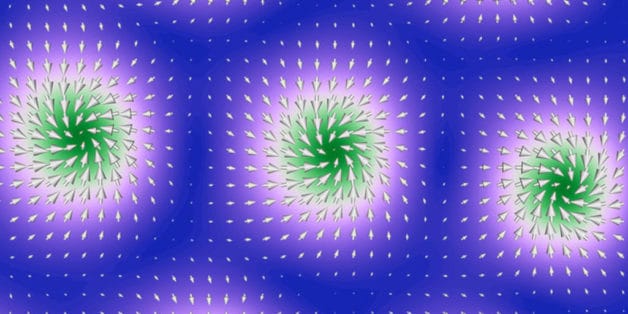Scientists have known for a long time that magnetism is created by the spins of electrons lining up in certain ways. But about a decade ago, they discovered another astonishing layer of complexity in magnetic materials: Under the right conditions, these spins can form skyrmions, little vortexes or whirlpools that act like particles and move around independently of the atoms that spawned them.
Because they are so stable and so tiny – about 1,000 times the size of an atom – and are easily moved by applying small electric currents, scientists are devising ways to harness them for new types of computing and memory storage technologies that are smaller and use less energy.
In a series of recent papers, scientists from Berkeley Lab, SLAC National Accelerator Laboratory, and UC San Diego describe experiments that suggest skyrmions can form a glass-like phase where their movements are so slow that they look like they’re stuck, like cars in a traffic jam. Further, they measured how skyrmions’ natural motion with respect to each other can oscillate and change in response to an applied magnetic field, and discovered that this inherent motion never seems to entirely stop. This ever-present fluctuation suggests that skyrmions may have a lot in common with high-temperature superconductors – quantum materials whose ability to conduct electricity with no loss at relatively high temperatures may be related to fluctuating stripes of electron spin and charge.
The research team was able to observe skyrmion fluctuations in a thin magnetic film made of many alternating layers of iron and gadolinium by taking snapshots with SLAC’s Linac Coherent Light Source X-ray laser beam just 350 trillionths of a second apart. They say their method can be used to study the physics of a wide range of materials, as well as their topology – a mathematical concept that describes how an object’s shape can deform without fundamentally changing its properties. In the case of skyrmions, topology is what gives them their robust nature, making them hard to annihilate.
“I think this technique will grow and become very powerful in condensed matter physics, because there aren’t that many direct ways of measuring these fluctuations over time,” said Sujoy Roy, a staff scientist at Berkeley Lab’s Advanced Light Source. “There are a huge number of studies that can be done on things like superconductors, complex oxides and magnetic interfaces.”


